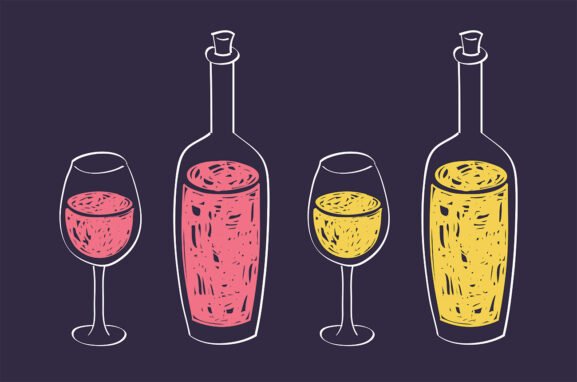How to Chill ‘Chillable Red’
Perusing the wine section at an independent grocery store near my house recently, I happened upon a display featuring “red wines that are best with a bit of a chill.”
Shelves like these have become increasingly common over recent years. If you haven’t noticed, chilled reds are all the rage these days, earning their own subsection on many wine bar and restaurant menus.
But, as someone who dutifully stores her red wines in the 55- to 60-degree (a.k.a. cellar temperature) range, I couldn’t help but over-analyze this casual bit of advice as I stood in the grocery store that day. What does “chilled” actually mean when it comes to red wine? Should I stick the bottle in an ice bucket a half an hour before pouring it, or pop it in the fridge for an hour?
Beyond the obvious sparkling reds, like Lambrusco, does chilled red ever signify actual fridge temperature—as in the advised serving climate for the OG American chilled red, Franzia Chillable Red? Indeed, its soft-grape juiciness bears some hints that apply to chillable reds as a whole—namely fruit-forward simplicity. “More flavor than blush wine, softer than traditional reds,” reads the descriptor.
“Even if it’s been said before, it’s worth repeating that red wine always tastes better if served colder than the room you’re in,” unless you keep your rooms in the 60s “like a French chateau in winter,” says Matt Sussman, Chicago wine pro and owner of Table, Donkey & Stick and Bar Parisette. For many of us, this means the baseline for red wine is more like what we’d consider cold. “When in doubt, 20 minutes in the fridge with every red is a good idea.”
Sussman and I tasted through some usual-suspect “chillable reds”—Gamay, Cinsault, Pinot Noir, a fruity nouveau blend—starting at just above fridge temperature. As we’d learn, there’s (annoyingly) no hard and fast rule for chilling red wine. But Sussman identified a few helpful guidelines and guardrails.
Clear Bottle = (Usually) Okay at Fridge Temperature
A clear glass wine bottle is probably the best visual indicator that the juice therein wasn’t meant to be aged. It also means it could probably take a chill like rosé, Sussman says. “If the winemaker was thoughtful, they thought about that—like, this can go in the fridge.”
We could surmise as much just by looking at Martha Stoumen’s Post Flirtation Red in its clear bottle. After tasting this juicy-red blend of Zinfandel, Carignan, Pinot Noir and Petite Sirah just above fridge temp (around 40 degrees) we deemed it a textbook example of nouveau red that’s delicious served cold.
“This is essentially grape juice, distinguishable from rosé in color only,” Sussman says.
Nouveau reds, or wines sold the same year they’re harvested, have minimal (if any) maceration time and a short fermentation period. They’re often light and fruity, with zippy acidity and minimal tannins—meant to be glou-glou’ed in one sitting and well-suited to chilling.
I’d later discover that a couple other light reds in clear bottles—namely Domaine de la Patience La Patience Vin Rouge (fruity Syrah and crunchy Carignan) and Bojo do Luar “Drasloup” (tangy, berry-like Alvarelhão)—went down just as easily right around fridge temp.
On the other hand, because wine seems to love frustrating exceptions, the recommended serving temp for the clear-bottled So Far Out Chilled Red from Field Recordings (a blend of Nebbiolo, Charbono and Chenin Blanc, aged in oak) is 60 degrees Fahrenheit due to its grippier tannins.

Higher Tannins Call for Closer to Cellar Temp
Tannins can be accentuated by cooler temps, as Sussman and I discovered while tasting Martin Texier La Boutanche Cinsault, a wine I often see grouped with chillable reds.
“It becomes grippier, almost grainy in an unpleasant way,” Sussman says. As the wine warmed on the table to around 50 degrees, we discerned the fresh tart cherry and raspberry that makes this such an easy drinking summer red.
Sussman would treat “tannic, Pinot Noir-like” Blaufränkisch the same. Indeed, I had a similar experience when I over-chilled Kir-Yianni’s “Cuvee Villages” Naoussa Xinomavro, then let it come closer to cellar temp. The tannins softened; the wine’s berry, earthy and smoky notes came alive.

Carbonically Macerated Bottles Like a Gentle Chill
On a related note, carbonic or semi-carbonic maceration also indicates the wine might like a chill. “Carbonic fermentation extracts a lot of pigment without a lot of tannin,” Sussman says. “It takes more time for tannin to steep into the juice.”
This technique, which originated in Beaujolais, involves putting grapes into a vat with their full clusters intact, allowing the grapes to press themselves with the pressure of carbon dioxide added to the vat. Winemakers around the world are testing this technique on all kinds of grapes—from St. Laurent and Zweigelt in Austria to Trousseau and Gamay.
When Sussman and I sampled the elegant and ethereal, cold carbonic-fermented Morgon Les Charmes Beaujolais Cru, we liked it best closer to chilly cellar temp, a.k.a. 55 degrees. It had lost some of its soft, fruity nuance when over-chilled. However, I discovered that Las Jaras Wines’s juicy, carbonic Slipper Sippers Nouveau (Lodi Zinfandel and Carignan) was light and fruit-punchy enough to sustain a heftier chill.

Don’t Underestimate the Ice Bucket
For more temperature control than the fridge or freezer, especially in a pinch, Sussman recommends keeping an ice bucket handy.
This would’ve helped as we progressively tasted Swick Wines’ hard-to-categorize, semi-carbonic Pinot Noir from cold to chilly. With each sip, we delighted increasingly in its mushroomy, plummy and tart cherry notes as it warmed to around 50 degrees.
Indeed, with a little ice bucket experimentation, I’d learn that juicy Occhipinti Frappato, with mellow tannins and rosy, cherry-like flavors sings at 50 or 55 degrees (or roughly a 45-minute ice bucket dunk), as does funky, freshly acidic Pipeño Tinto País.
What stuck with me most from our tasting was Sussman’s straightforward advice from the beginning: pay more attention to the temperature of red wine. But there’s still no need to stress, he says, “If it’s overchilled, it’s gonna warm up relatively fast, unless you’re trying to pound it.”
More Chilled Red Coverage

Published: September 10, 2024

